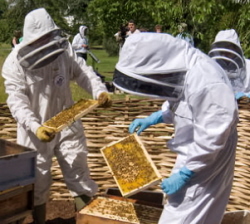How Do You Keep Honey Bees?
Plight of the humble bee
As widely reported in the media over the last six months or more, see the linked Times article for example, bees are in crisis and without them much of our environment is at risk. One third of bee colonies died in France over the last few years. Over 4000 bee colonies died in London in recent winters.
Kew Gardens has recently installed two bee colonies on site as there were no bees in residence and the garden is a paradise for bees and Kew's Senior Bee Advisor, Anthony Smith, gave a lecture this week on how it's done.
In order to start a new hive a new queen is needed. British bees died out in 1929 so queens are often sent over from New Zealand, as their bees are particularly docile and non-aggressive, which is important for any beekeeper, let alone the many visitors to Kew. They are sent in a tiny plastic box with a few workers and enough candy to keep them happy and are tested for disease before being carefully and slowly released into a new hive with beekeepers taking up to 48 hours between the first introduction and letting the queen free. Care is needed to prevent existing workers from mobbing the new queen to death as they have been separated from an existing hive to form the new colony and take less than 30 minutes to realise they no longer have a queen. A hive is made up of workers, drones and a queen with all the bees in a hive taking on a similar colour and shade as they inherit it from their queen.
It takes 6 weeks to establish a queen and get the colony started. The Kew Bees were transported to Kew and then left for a week to recover before being transferred into their new hives. They produced 40 pounds of surplus honey the first season.
The queen lays eggs which hatch out into workers 21 days later and they can travel up to 6 miles in search of nectar and pollen, starting work within two minutes after birth. They return to the hive and do a 'waggle' dance inside the hive, in the dark to tell the other workers what's available and where. A worker lasts 6-8 weeks and produces one twelfth of a teaspoon in a lifetime. It takes nine pounds of honey to produce one surplus pound of honey available for human consumption, the rest being used by the bees and the workers will collectively travel up to 3 times round the world in order to achieve it, They travel incredibly efficiently, up to 7 million miles on a gallon of honey.
The drones are slightly larger than the workers, with bigger eyes. Those with the largest eyes find it easiest to spot the queen when she rises for her mating flight and she will mate with up to 14 of these in the one flight. She then returns to the hive to lay her eggs. By September time the workers will stop feeding the drones and eventually push them out of the hive to die.
The queen then hibernates for much of the winter, although that season is shrinking, with 10-15000 workers and few if any drones. Bees eat the stored honey over the winter and convert it to heat, keeping a constant temperature between 21-25 degrees Celsius. An average colony requires forty pounds of honey to get them through the winter. Mouse guards need to be placed at the entrance to the hive or else the mice will enter the hive, find a nice cosy warm spot with plenty of honey and settle down for the winter eating the honey and ruining the wax.
There are many reasons for the decline of bees. The varroa parasite is the main reason, a parasite which settles into the cells with newly laid eggs before the cells are sealed on day 9 and reproduce twice before the egg is hatched having partaken of the food in the cell so the emerging drone or worker is a lot weaker than it should be.
Climate change plays its part as bees used to hibernate from September but can still be seen up to December, sometimes getting caught by the bad weather and not being able to return. Investigations are being carried out as to the gene pool from which the queen is selected as to whether it is wide enough. Pesticides on the pollen affect the bees and the wax and honey produced are being analysed.
If you are interested in keeping bees in your garden, allotment or in the Ealing apiary, please visit Ealing Bee Keepers (even if not resident in Ealing) who will be happy to give you a tour and introduction, with lots of support available if you decide to give it a go. Membership of a beekeepers association brings with it membership of the national British Bee Keepers Association which in turn insures your beekeeping.
Information about talks at Kew Gardens are available at their website. They are open to Kew members at a cost of £4
October 9, 2009
Related links
|
